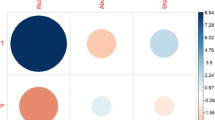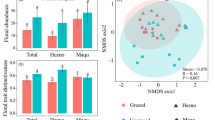Abstract
The movement patterns of carpenter bees (Xylocopa micans) and bumblebees (Bombus pennsylvanicus) foraging for nectar on vertical inflorescences ofPontederia cordata were studied near Miami, Florida. The floral biology ofP. cordata is unique in several ways: (a) many short-lived flowers per inflorescence, (b) constant nectar production throughout the life span of each flower, and (c) abscence of vertical patterning of nectar and age of flowers. Inflorescences ranged between 3.5 and 15.8 cm long and had between 9 and 55 open flowers. Both carpenter bees and bumblebees arrived mostly on the bottom third of the inflorescence and left after visiting flowers on the top third of the inflorescence. The departure position from the inflorescence was higher up than observed in studies of other insect pollinators foraging on other speces of plants. This pattern of departure probably occurs in the absence of a vertical gradient of nectar or floral morphology.
Similar content being viewed by others
References
Bell, C. R., and Taylor, B. J. (1982).Florida Wildflowers and Roadside Plants, Laurel Hill Press, Chapel Hill, NC.
Best, L. S., and Bierzychudek, P. (1982). Pollinator foraging on foxglove (Digitalis purpurea): a test of a new model.Evolution 36(1): 70–79.
Dreisig, H. (1989). Nectar distribution assessment by bumblebees foraging at vertical inflorescences.Oikos 55: 239–249.
Galen, C., and Plowright, R. C. (1985). Contrasting movement patterns of nectar-collecting and pollen-collecting bumble bees (Bombus terricola) on fireweed (Chamaenerion angustifolium) inflorescences.Ecol. Entomol. 10: 9–17.
Harder, L. D., and Barrett, S. C. H. (1992). The energy cost of bee pollination forPontederia cordata (Pontederiaceae).Funct. Ecol. 6: 226–233.
Heinrich, B. (1979). Resource heterogeneity and patterns of movement in foraging bumblebees.Oecologia 140: 235–245.
Hodges, C. M. (1985). Bumble bee foraging: the threshold departure rule.Ecology 66(1): 179–187.
Ipe, D. (1987). Performing the friedman test and the associated multiple comparison test using Proc GLM.Proceedings of the 12th Annual SAS USERS Group International Conference, SAS Institute, Cary, NC, pp. 1146–1148.
Kadmon, R., and Shmida, A. (1992). Departure rules used by bees foraging for nectar: A field test.Evol. Ecol. 6: 142–151.
Kadmon, R., Shmida, A., and Selten, R. (1991). Within-plant foraging behavior of bees and its relationship to nectar distribution inAnchusa strigosa.Isr. J. Bot. 40: 283–294.
Kevan, P. G. (1990). How large bees,Bombus andXylocopa (Apoidea Hymenoptera) forage on trees: optimality and patterns of movement in temperate and tropical climates.Ethol. Ecol. Evol. 2: 233–24.
Lowden, R. M. (1973). Revision of the genusPontederia L.Rhodora 75: 426–487.
Ornduff, R. (1966). The breeding system ofPontederia cordata L..Bull. Torr. Bot. Club 93(6): 407–416.
Pleasants, J. M., and Zimmerman, M. (1979). Patchiness in the dispersion of nectar resources: Evidence for hot and cold spots.Oecologia 41: 283–288.
Pyke, G. H. (1987a). Optimal foraging in bumblebees and coevolution with their plants.Oecologia 36: 281–293.
Pyke, G. H. (1978b). Optimal foraging in hummingbirds: testing the marginal value theorem.Am. Zool. 18: 739–752.
Pyke, G. H. (1979). Optimal foraging in bumblebees: Rule of movement between flowers within inflorescences.Anim. Behav. 27: 1167–1181.
Richards, J. H., and Barrett, S. C. H. (1987). Development of tristyly inPontederia cordata (Pontederiacea). I. Mature floral structure and patterns of relative growth of reproductive organs.Am. J. Bot. 74(12): 1831–1841.
SAS Institute (1990).SAS/STAT User’s Guide. SAS Institute Inc., Cary, NC.
Waddington, K. D. (1981). Factors influencing pollen flow in bumblebee-pollinatedDelphinium virescens.Oikos 37: 153–159.
Waddington, K. D., and Henrich, B. (1979). The foraging movements of bumblebees on vertical “inflorescences”: An experimental analysis.J. Comp. Physiol. 134: 113–117.
Wolf, L. L., and Hainsworth, F. R. (1986). Information and hummingbird foraging at individual inflorescences ofIpomopsis agregata.Oikos 46: 15–22.
Wolfe, L. M., and Barrett, S. C. H. (1987). Pollinator foraging behavior and pollen collection on the floral morphs of tristylousPontederia cordata L.Oecologia 74: 347–351.
Wolfe, L. M., and Barrett, S. C. H. (1988). Temporal changes in the pollinator fauna of tristylousPontederia cordata, an aquatic plant.Can. J. Zool. 66: 1421–1424.
Zimmerman, M. (1988). Nectar production, flowering phenology, and strategies for pollination. In Doust, J. L., and Doust, L. L. (eds.),Plant Reproductive Ecology, Patterns and Strategies, Oxford University Press, New York, pp. 157–178.
Author information
Authors and Affiliations
Rights and permissions
About this article
Cite this article
Orth, A.I., Waddington, K.D. The movement patterns of carpenter beesXylocopa micans and bumblebeesBombus pennsylvanicus onPontederia cordata inflorescences. J Insect Behav 10, 79–86 (1997). https://doi.org/10.1007/BF02765475
Revised:
Issue Date:
DOI: https://doi.org/10.1007/BF02765475




